Jeju City
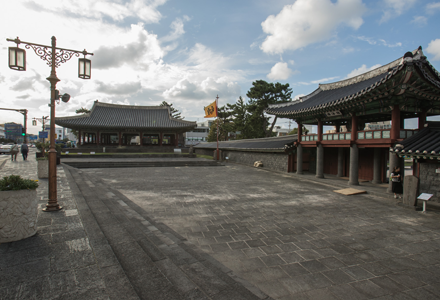
Gwandeokjeong Pavilion
Gwandeokjeong Pavilion was built as a training ground by Pastor Sin Suk-cheong in the 13th year of King Sejong’s reign (1448). On March 1, 1947, people congregate here for a ceremony commemorating the Independence Movement of 1 March 1919. When they left the area, six people were killed and eight were injured due to police shooting into the crowd. This resulted in an unprecedented general strike on the island and many Jeju Islanders were later detained and tortured at the police station on this site.
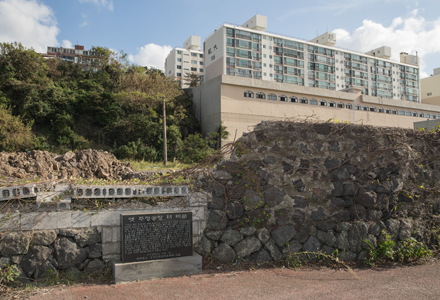
Former Distillery Site
The Oriental Development Company Jeju Distillery was established in 1934 by Japan and it was an important industrial facility before and after liberation. The warehouse of the distillery was used as a detention center during the Jeju 4.3 Uprising and Massacre. In the spring of 1949, people who were arrested as part of pacification activities were detained in this warehouse, and many of them died due to the severe conditions and torture.

Jeongtteureu Airport
Jeongtteureu Airport, which is the current location of the Jeju International Airport in Jeju City, was the largest massacre site during the Jeju 4.3 Uprising and Massacre. From the end of December 1948 to March 1949, Jeju residents were dragged to this location, shot dead and then buried here. In December 1949, 249 death row inmates sentenced by a military court were shot dead at this very spot. After the start of the Korean War in 1950, people who were involved in the Jeju 4.3 Uprising and Massacre were kept in preventive custody and then massacred at this site. From 2007 to 2009, projects to excavate bodies were conducted and 388 bodies were found.

The Lost Village of Goneul-dong
There were around 70 households in Goneul-dong when on Jan. 4, 1949, soldiers burned the village to the ground. Soldiers invaded the village without warning, burned all the houses and killed many villagers. Among the villages that were destroyed during the Jeju 4.3 Uprising and Massacre, the ruins of Goneul-dong are relatively well preserved. But the village was never restored.
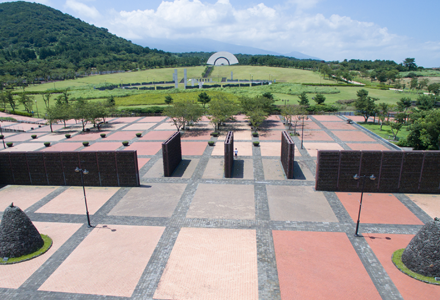
Jeju 4·3 Peace Park
The Jeju 4·3 Peace Park was established to remember the tragic history of the Jeju 4.3 Uprising and Massacre, restore victims’ honour and promote Jeju as an island of peace and human rights. It is a must-visit destination to learn about the Jeju 4.3 Uprising and Massacre.
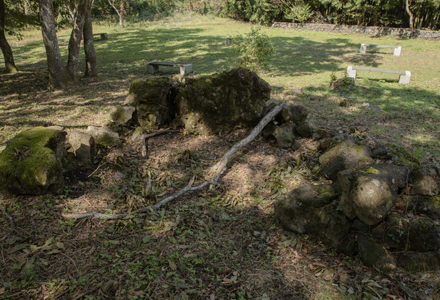
Gwaneumsa Temple
Gwaneumsa Temple was established in 1909 close to Eoseungsaeng, which was a base camp for the armed resistance, meaning the temple suffered greatly during the Jeju 4.3 Uprising and Massacre. From March 1949, the 2nd Battalion reinforced its plan to crack down on the armed resistance and stationed its 2nd Regiment at the temple. The Battle of Gwaneumsa occured between the armed resistance and the army. In December 1949, eight buildings were burnt down by the army.
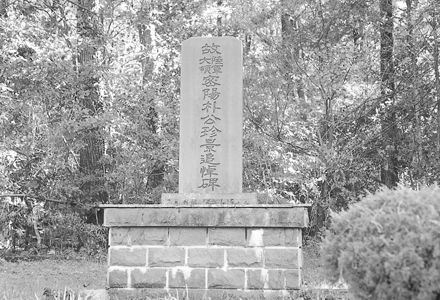
Jeju City Cemetery for the Loyal Dead
Memorial stones for soldiers and police officers who were killed during the Jeju 4.3 Uprising were erected at the Jeju City Cemetery for the Loyal Dead located in Jeju City. Colonel Park Jin-gyeong, whose memorial stone is at the cemetery entrance, was deployed to Jeju as the commander of the 11th Regiment in May 1948 and was known for his severe repression operation. In June 1948, he was assassinated by his subordinates in the barracks while sleeping.
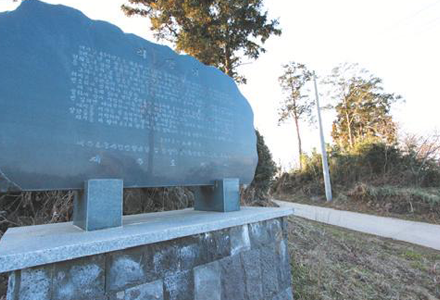
The Lost of Village Risangyi
Risangyi was the largest neighborhood in Haean-ri. Around 80 households lived here farming either livestock or crops. On Nov. 21, 1948, the village was burnt down by the army and was never able to recover. It is one location on Jeju that retains well-preserved remains of a village razed during the the uprising and massacre.
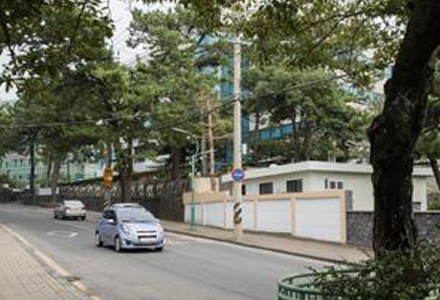
The Former Site of Jeju Agriculture School
The Jeju Agriculture School was the only higher education institution on Jeju during the massacre and the 9th Regiment was stationed here. The student movement was strong and active on Jeju, first for independence from Japanese colonization and then, following liberation, against the U.S. occupation. When students actively joined the ceremony to commemorate the Independence Movement of 1 March 1919, some were killed only because they were Jeju Agriculture School students. While the 9th Regiment was stationed here, it became a center of persecution, and many people were detained and tortured in temporary detention tents installed at Jeju Agriculture School.
Jocheon-eup

Moksimul cave
On Nov. 21, 1948, Seonheul-ri was burnt down and its villagers hid in Moksimul cave where they were eventually found by the Korean army and killed. The 9th Regiment of Hamdeok then discovered Seonheul-ri villagers hiding in Doteul cave and killed them as well. The next day, the army killed around 40 villagers hiding in Moksimul cave. Then the 9th Regiment tortured people and found other hideouts such as Daesubyi cave and Benbaengdui cave, and killed the people who were hiding there as well.
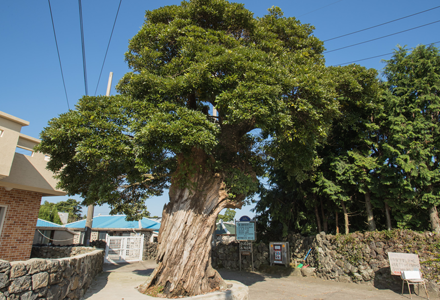
Bulkabunnang (burnt tree) in Seonheul-ri
On Nov. 21, 1948, most of the houses in Seonheul-ri were burnt down during a severe crackdown. At that time, a nettle tree in the village was also burned. It was thought that the tree was completely destroyed. During spring, however, leaves still budded from its branches. Although half of the tree died, the other half is still alive and the seed of an amur maple tree sprouted next to it and they have grown together for decades.
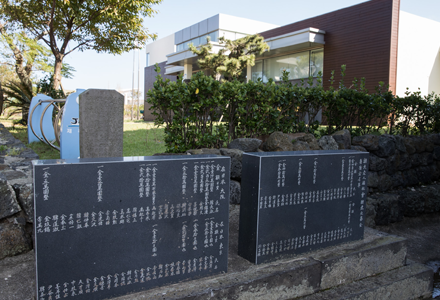
Jocheon Police Station and Former Site of Jocheon School
Jocheon School was built in March 1946 by local villagers. Most teachers were outstanding individuals who studied abroad, such as in Japan, and were connected to the South Korean Labor Party. Most of them were killed during the Jeju 4.3 Uprising and Massacre. Following the Shooting Incident of March 1, 1947, Jocheon School was suppressed by the U.S. Military Government and it became difficult to operate as intended. Then on March 6, 1948, Kim Yong-cheol, who was a second-year student at Jocheon School, was tortured to death at the Jocheon police station.
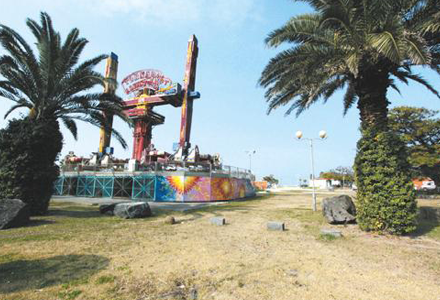
Former Site of the Military Base in Hamdeok Elementary School
The Korean army’s 9th Regiment and 2nd Regiment were stationed at Hamdeok Elementary School. For those from villages around Jocheon-myeon and Gujwa-myeon, the Hamdeok military base was an unforgettable nightmare. The army brought in anyone they even slightly suspected of cooperating with the armed resistance. Once arrested, most of them were not able to leave the base alive.
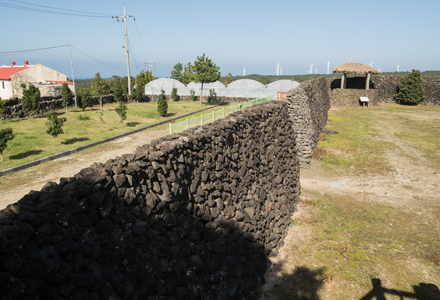
Nakseon-dong April 3rd Fortress
When Seonheul-ri was burnt down on Nov. 21, 1948, villagers hid in nearby hills or moved to coastal villages. The government permitted the surviving villagers to return to their hometowns in the spring of 1949 but only after the villagers had completely built a square-shaped stone enclosure around their villages. The fortress-like enclosure was purportedly built to block and prevent attacks from the armed resistance but in reality they were used by the government to effectively contain and control the movement of the villagers.

Neobeunsungee and Bukchon Elementary School
Bukchon-ri was hit the hardest during the Jeju 4.3. Uprising and Massacre, with 450 villagers killed by the army. The Bukchon Massacre was committed by the 2nd Regiment, without regard for gender or age. The Neobeunsungee April 3rd Park was established to pay condolences to the victims.
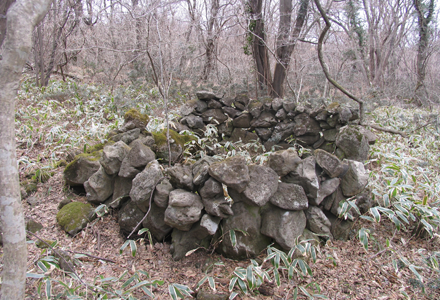
Lee Duk-koo’s Uplands
On Nov. 20,1948, following a crackdown in Bonggae-ri, villagers took refuge in the nearby mountains. Lee Duk-koo’s Upland is where villagers hid during the severe crackdown.It is named after Lee Duk-koo, a general commander of the armed resistance, who stayed here temporarily after the spring of 1949.
Aewol-eup
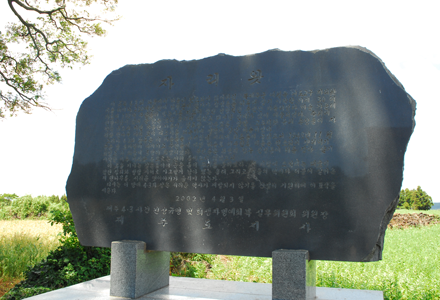
The Lost Village of Jariwat
Eodo 2-gu consisted of seven villages: Jariwat, Yeollyuwat, Jireumki, Godoriwat, Malbat, Sangsumoreul and Hwajeon-dong. All of them except for Hwajeon-dong were forcibly evacuated from Nov. 23 to 25, 1948. Even today, none of the seven villages has been restored and most of the evacuated villagers are living in Sinmyoung-dong, which was newly established in 1-ri.
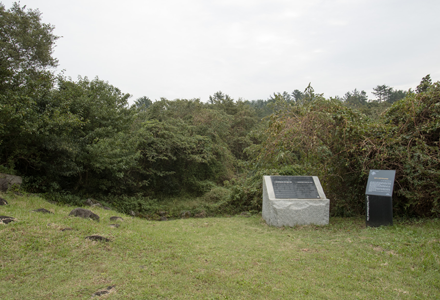
Bilaemot cave
A joint mission between state and private forces discovered Bilaemot cave in 1949. At that time, around 29 villagers from Eoeum, Namwon and Jangjeon were hiding there. The army killed them in a nearby area. It was reported that a boy from the village was held up by his foot and then repeatedly smashed against a rock until he was dead. In 1973, the bodies of seven people who had hid from the massacre were found in the cave.

Youngmowon
On May 27, 2003, villagers of Hagwi-ri built Youngmowon to pay tribute to activists who fought for independence during Japanese colonization as well as the people who died during the Korean War and the Jeju 4.3 Uprising and Massacre. It became a model of reconciliation and coexistence as the state forces killed by the armed resistance and villagers who were killed by the state forces are both commemorated here.
Gujwa-eup
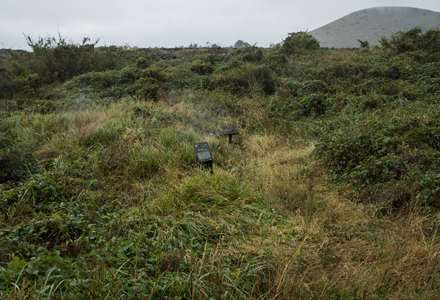
Darangshi cave
Eleven villagers of Hado-ri and Jongdal-ri hid from the massacre in Darangshi cave until they were discovered by state forces in 1948. The army urged the villagers to come out. The villagers did not heed the demand, and the army made a fire at the entrance of the cave, filling it with smoke, and suffocating everyone inside. In 1992, all 11 dead bodies were found undisturbed and it triggered a truth-finding campaign into the Jeju 4.3 Uprising and Massacre.
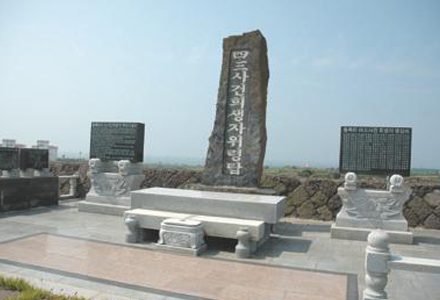
4·3 Memorial Park in Dongbok-ri
On Dec. 19, 1948, of the lunar calendar, the army assembled villagers of Dongbok-ri at the so-called Jangbok field and killed 86 adults. Afterwards, the army came down to the village, set fire to houses and killed even more people. As of today, 136 people from Dongbok-ri have been reported as victims. This memorial park was established in December 2007.
Seogwipo
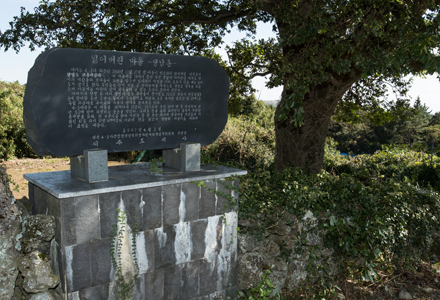
The Lost Village of Youngnam-dong
At the time of the Jeju 4.3 Uprising and Massacre, around 16 households lived in Youngnam-dong. On Nov. 18, 1948, an order of forcible evacuation was made under the army’s scorched-earth policy, and most villagers hid in nearby forests or caves. Unfortunately, the majority of the 16 households were killed by the army and the village was never restored. The village was the only slash-and-burn agricultural field in Jeju and its ruins are well-preserved.

Memorial Altar for Victims of Preliminary Imprisonment
This place memorializes the 81 victims (14 from Seogui-myon, 45 from Jungmun-myon and 22 from Namwon-myon) who were killed while being detained during the Korean War. On July 29, 1950, the victims were taken by truck in the early morning, never to be seen again. This memorial altar was built in Hawon-ri village and a memorial ceremony is held on June 15 of the lunar calendar every year.

Si Oreum Station
The police station at Si Oreum was established in early 1950. At that time, around 25 stations were built on the major roads of mountains to prevent the armed resistance from connecting with villagers. The Si Oreum police station is a triangle-shaped building and has gun holes in strategic places. Inside the station, the lodgings where army and civilian cooperatives slept still remain.
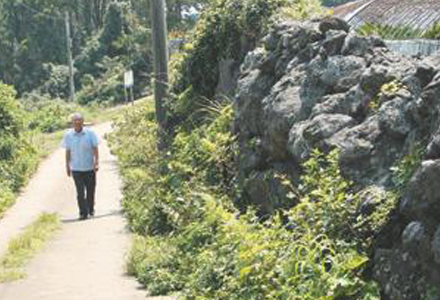
Beophwan-ri Jeju 4·3 Fortress
When the outer fortress was first constructed, it was not very high so an inner fortress was built to provide more protection for the village from the armed resistance. Villagers who lived outside the inner fortress then moved inside. Currently, some parts of the fortress can be found by the seaside around Beophwan-ri village.
Ahndeok-myeon

The Lost Village of Mudeungyiwat
Mudeungiwat in Donggwang-ri village was a an area cultivated by slash-and-burn agriculture, established around 300 years ago. In early November 1948, the military’s scorched-earth policy was executed in Mudeungiwat and villagers were scattered throughout the area and then hunted down by the army. Since it was a big village with 130 households, the tragedy was immense. In 2001, a sign indicating the location of the lost village was erected here by the local government.

Keunneolgwe cave
After Donggwang-ri village was burnt down in the middle of November 1948, around 120 villagers hid inside Keunneolgwe cave for two months. In early 1949, however, Keunneolgwe cave was discovered by the army and the villagers ran towards Mt. Hallasan for safety. Unfortunately, they were caught near Bolleh Oreum and immediately shot to death or captured and sent to Seogwipo. Among them, around 40 people were killed near Jeongbang Waterfall.
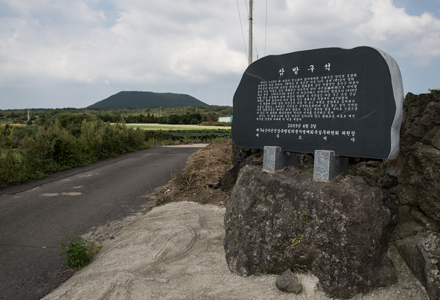
The Lost Village of Sambat Corner
In Donggwang-ri village’s Sambat corner, Chinese yam once grew. During the Jeju 4.3 Uprising and Massacre, Sambat consisted of 46 households of the Lim family. At the end of November 1948, the military’s scorched-earth policy was ordered and the villagers hid in Keunneolgwe cave. Some of them fled to Mt. Hallasan but were found by the army and killed near Jeongbang Waterfall. A memorial stone and a sign indicating the location of the lost village have been erected.
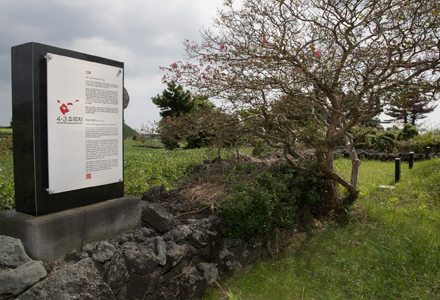
The Empty Graves of the Lim Moon-sook Family
This is the Lim Moon-sook family cemetery. Mr. Lim and his family were hiding in Keunneolgwe cave when Donggwang-ri village was burnt down by the army in November 1948. Once the army discovered the cave, the Lim family tried to escape into the mountainous areas of Mt. Hallasan. However, they were captured near Bolleh Oreum and executed near Jeongbang Waterfall. The remaining family members were unable to find the bodies of Lim Moon-sook and his family, so they performed a ritual to call their souls and dug empty graves. In total, there were nine victims.
Daejeong-eup
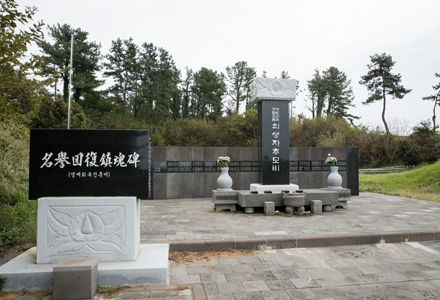
Seodal Oreum
Right after the Korean War broke out in 1950, preventive detention swept across Korea, and Jeju was no exception. People who were identified as targets for preventive detention were killed by soldiers. Around 374 villagers from Hanrim, Hangyeo-ng, Daejeong and Andeok were identified as targets for preventive detention and among them, 150 people were detained in a storage facility in Daejeong. On Aug. 20, 1950, these 150 people were killed at Seodal Oreum. The victims were loaded into trucks. From the back of the trucks, they dropped their shoes so their families could follow the trail to find their dead bodies.

Baekjoilsonjiji
The remains of 132 victims who were killed at Seodal Oreum are enshrined here. After the victims were executed, the army did not allow the bereaved families to take the bodies of their loved ones, so the families made this graveyard six years after the executions. At that time, it was not possible to identify the bodies so the families assembled a communal graveyard for all the victims. This is where the cemetery’s name comes from: Baekjoilson means 132 ancestors who died at the same time in the same place. As the bones of their loved ones were all buried together, their descendants now consider themselves as one family.
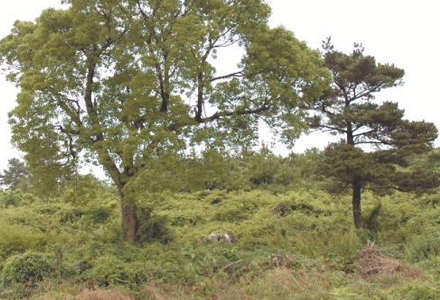
Hansoogigot
Hansoogigot is a gotjawal forest located northeast of Inhyang-dong, Mooreung 2-ri village. During the Jeju 4.3 Uprising and Massacre, the villagers from Daejeong-myeon and Hangyeong-myeon who were unable to evacuate hid in this forest. Also, the armed resistance temporarily used this location as a base camp.
Namwon-eup
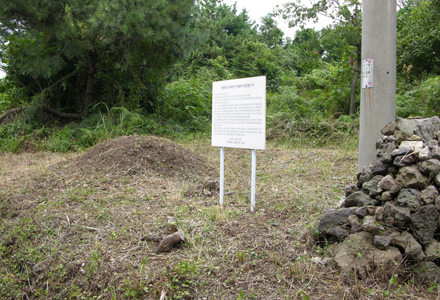
Songryeongigol
Songryeongigol is where the bodies of the armed resistance were buried after they lost their lives during a fight with the military at Uigwi Elementary School. On that day, four soldiers were killed while many more died among the armed resistance. Their bodies were left to rot until the next spring when they were moved and buried in the current burial ground under order of the army. In May 2004, the “Life Peace Medicanct Pilgrimage Group” cleaned up the grave site and ever since then every year civil association have taken care of the site.
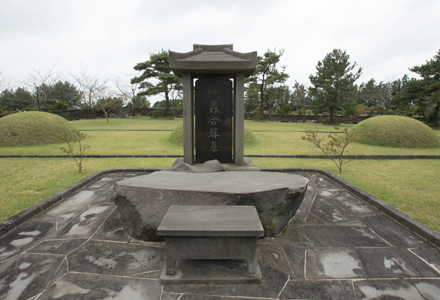
Hyeonuihapjangmyo (graveyard)
Bodies in the current Hyeonuihapjangmyo used to be in old graveyards and were moved to this location in September 2003. On the excavation day, a total of 39 bodies were found in three burial mounds. The bodies were cremated and reburied in three burial mounds.
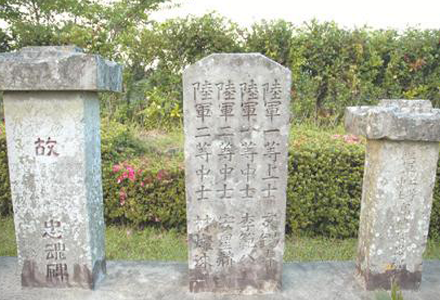
Memorial Stones at the Namwon Cemetery for the Loyal Dead
At the Namwon Cemetery for the Loyal Dead, a number of tombstones and memorial stones of soldiers and victims can be found. The memorial stones of Go il-soon, Kang Hang- jin, Kang Gi-hyung and Kim Tae-hoo, members of the civilian army who died on the job, can be found here.
Hanrim-eup
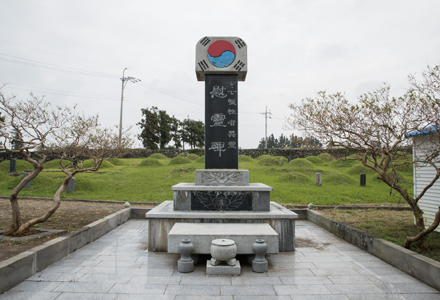
Manbengdui Cemetery
A number of people who were detained during preventive detention maneuvers and killed at Seodal Oreum are buried here while others are buried in Baekjoilsonjiji. They were detained in Hanrim and Mooreung police stations and around 63 people were killed on the day.

Sangdong Jeju 4.3 Fortress, Myeongwol-ri
Sangdong April 3rd Fortress is a part of a fortress that was built in 1949. At that time, around 10 households lived in one house. Two years after the fortress’ construction, it was deemed too small to accommodate the households and another outer fortress wall was built. The original fortress was the inner fortress and the newly built fortress was the outer fortress. Only 300m of it remains today.

The Late Jin A-young ’s House
Jin A-young was shot in the face during the Jeju 4.3 Uprising and Massacre and lived the rest of her life here without her chin. She passed away on Sept. 8, 2004, and lived in this house until her last day. Her house is now open to visitors and exhibits her relics.
Pyoseon-myeon

Hanmosal
Hanmosal, which means a long sandy beach, is located in Pyoseon-myeon. It is also called ※Dangkae or Pyoseon sandy beach. This was the massacre site where villagers of Pyoseon-myeon and Namwon-myeon were killed. During a week in December 1948, around 200 villagers from Tosan-ri village were killed here including the wife and children of Jo Mong-gu, executive member of South Korean Labor Party.
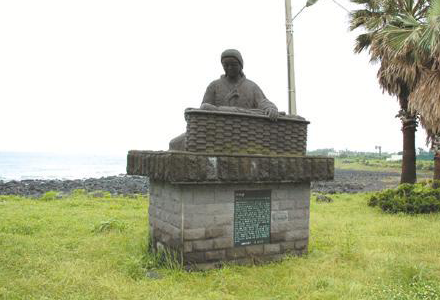
Mother and Child Statue in Tosan-ri Village
The Mother and Child Statue in Tosan-ri village was built in 2002 by an artist to praise all mothers who suffered greatly during the Jeju 4.3 Uprising and Massacre. “Thank you very much for taking care of us, mothers! The people are the ones who suffer when a country is in trouble!” is engraved on this statue.
Seongsan-eup
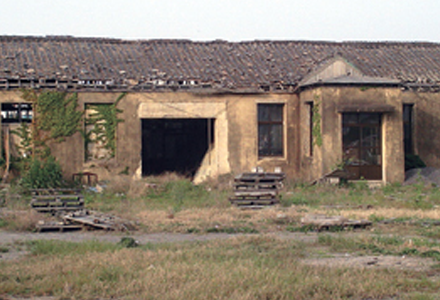
Former Base Camp Site of the Northwest Youth Association Special Squadron at Seongsan Elementary School
Around 100 members of the Northwest Youth Association Special Squadron stayed at the Seongsan Elementary School for three months. Villagers who remembered this place gave testimony of people screaming while being severely tortured and people who were dragged to the massacre site. The frame of the building can be found behind the Songsan-ri K-mart.
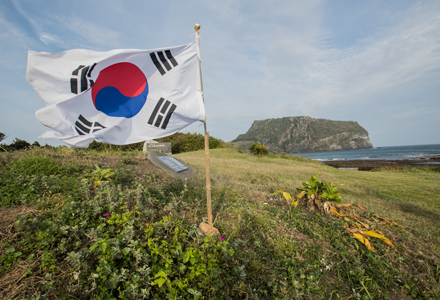
April 3rd Memorial Park of Seongsan-eup (Teojinmok)
Teojinmok was a massacre site where villagers of Seongsan-myeon and Gujwa-myeon were dragged to by the Northwest Youth Association Special Squadron, detained at the potato storage house, tortured and then killed. The Seongsan-eup Association of Bereaved Families of the April 3rd built a memorial stone and memorial on the site in November 2010.